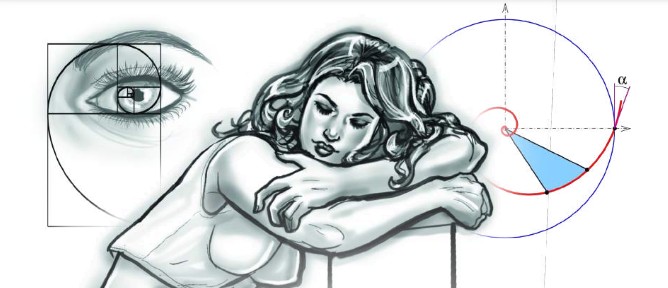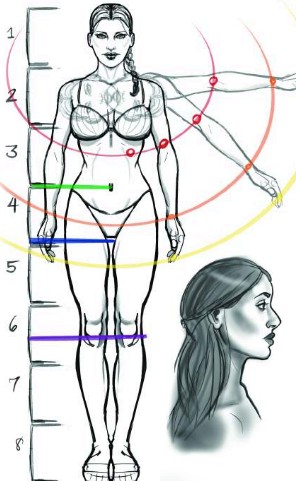
By Mindy Wheeler
When it comes to mastering human proportions, you’ve probably never thought you were practicing visual mathematics, but you are! Specifically, when you’re drawing humans, you’re inevitably drawing the “Golden” (phi) ratio in the Fibonacci spiral. This sequence is prevalent in all things in our universe, from the patterns of broccoli to spiral galaxies, and even in the irises in your eyes.
Biologically, it manifests itself in our bodies over and over again. Being a person who is equally left and right-brained, this knowledge is comforting to me. But if you don’t like math, don’t worry—all you need to do for this first exercise is count to 8.

Before we get to that, I’d like to share why I decided to narrow in on proportions. It’s probably the BIGGEST mistake I see artists make—even successful ones. Once you see it, you can’t UNSEE it. Furthermore, I’d propose it’s one of the easiest mistakes to fix! So, I remind every artist, there’s always a good time to freshen up on proportions. Any anatomically well-versed artist can easily spot another artist who’s trying to “fake it until you make it,” so save yourself the trouble and take some time to learn!
If you can just count your bodies by 8, you’re already ahead of the game, but expect to continue counting to 8 for the next few years, at least. I’ve been drawing ever since I could remember, yet still, with every new piece, I’m constantly measuring my proportions and counting to 8.
For this exercise, I’ll draw a couple of poses from my imagination and show you my process of how I double-check my proportions. Follow along. Men and women have slightly different proportions, but drawing women is my forte, so let me start there.
A woman’s body should be 7-8 heads in length. The way I measure is to take my thumb and measure as follows:
- 1st head: from the top of the head to the chin.
- 2nd head: from the clavicle to about the middle of the ribs.
- 3rd head: ends at the belly button.
- 4th head: ends at the pelvis.
- 5th head: within the thighs.
- 6th head: envelopes the knees.
- 7th head: the shins.
- 8th head: from the lower legs to the feet.
As cliché as it may be, the Da Vinci Vitruvian Man really hits the nail on the head when it comes to swinging elbows and knees, something I constantly imagine when I draw. Imagine your arms extended to your side, like chicken wings. Now, as you bring your elbows back down to your side, your elbows should swing right back into your ribs. Try it.
Similarly, the wrists and hands should always be able to swing outward like Da Vinci’s Vitruvian Man and line up right around the pelvis when they touch back down. I kept this in mind when I drew the woman sleeping on the imaginary chair on the next page. See how I counted to 8 all the way down and also visualized where her elbows and hands would lay if she were sitting upright, according to our Vitruvian Man exercise.
As you study more about the body in detail, you’ll notice more and more ways to measure your anatomy to keep it in line, such as the manifestations of the Fibonacci sequence in the face. The ends of the lips line up with the iris in the eyes, the ears line up with the nose, and the width of the nose should be the same as one eye. Shoulders should be the width of about two heads, and so on.
Keep in mind when you practice—comic book artists should draw from their imagination. While photo references are necessary for study, when push comes to shove, the test of skill really comes from being able to pull from your unique and original mental images and then masterfully render those onto paper. It’s usually easy for any artist to do a rough sketch but then they typically drop the ball and move on to photo references, skipping the skill of rendering their roughs completely. This can lead to a crutch of photo dependence, which is why comic art takes many years of practice.
If you can master refining from your imagination, you’ll be unstoppable in what worlds you can create. Don’t stop practicing. Draw every day. The more you do, the more connections your brain builds, enabling you to improve your skills in ways you didn’t initially realize.
Take your drawing to the next level with me by turning and twisting the body for this second exercise, keeping in mind your 8 count and the Vitruvian Man! Draw out your rough sketch. Try to use familiar shapes for each body part. Some comic book artists, like one of my favorites, David Finch, can do this step with extreme precision, but my sketches tend to be really loose in the beginning, and that’s okay. Comic book art is NOT about perfection; don’t forget that.
Now, remember your proportions. I chose a pose where I could move one elbow forward and one back, so we could get a good exercise with the “elbow swing.” Visualize lifting the elbow so it’s slightly above the ribs. It should still be able to swing backward and line up correctly.
Here’s where you really have to trust the process. You’re now carving out the potential you laid down in your rough sketch, but this isn’t always a comfortable place for new artists. Your knowledge of anatomy will be tested here. The skill of going from rough sketch to beautifully refined line work is possessed by all the greats of the industry. Remember again, your lines don’t have to be perfect. Comic Book art tends to be forgiving. I know I could improve with my lines here, but that’s not the goal. If you strive too much for perfection, it will drive you crazy. Improvement comes with practice over time.
What I do is place my thumb and forefinger over the head to measure one head, then count down the body: 2, 3, 4, 5, and 6 should be right at the knees, as in this sketch. If you stay within these general 1-8 proportions, you should be close enough that it looks acceptable. Notice the yellow on the elbows where you can visualize them touching the ribs.
To recap:
- 1st head: from the top of the head to the chin.
- 2nd head: stops at the middle of the ribs.
- 3rd head: hits the belly button.
- 4th head: at the pelvis.
- 5th head: inside the thighs.
- 6th head: at the knees.
- 7th head: at the shins.
- 8th head: at the feet.
Make adjustments as needed.
Coloring is its own skill with all its own rules, but a light airbrushing on my iPad will give you a decent idea of what the finished piece could look like. The fluidity of going from a rough sketch to a rendered piece without photo references makes the medium unique, stylistic, and natural. You won’t get the movement, freedom, and soul in your artwork any other way. That’s what I love about comic book art. So, while maybe this isn’t 100% perfect, it still captures the moment of a beautiful woman at the beach.
Try it yourself! Practice, practice, practice, True Believers, and never give up!
